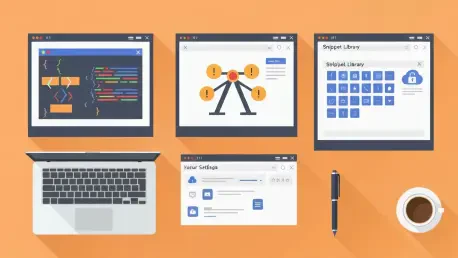AI coding assistants no longer feel like a parlor trick that autocompletes boilerplate; they read context across repositories, tests, configs, and documentation to propose code that holds up to real-world scrutiny and time pressures far better than older tools ever did, and they have started to take on carefully bounded tasks that used to require a junior developer’s full attention. That shift has raised a sharper question for engineering leaders and hands-on builders alike: which combination of tools, not which single tool, supports the stack, governance stance, and throughput targets that define modern software delivery. The market now divides into clear categories—general-purpose copilots, enterprise-grade assistants with strong privacy controls, ecosystem specialists, and quality or knowledge layers that harden output. Choosing well depends on understanding how each option captures context, embeds into the workflow, respects identity and policy boundaries, and scales from spontaneous prompts to repeatable practices. The goal is not just speed; it is sustainable acceleration that keeps code trustworthy, searchable, and explainable.
The AI Coding Landscape in 2025
From Autocomplete to True Pair Programming
The conversation has shifted from clever snippets to end-to-end collaboration inside the IDE, where assistants synthesize signals from open files, project structure, test suites, and even inline comments to produce full functions, refactor safely, and draft unit or integration tests that match the house style. Chat surfaces in Visual Studio Code, JetBrains IDEs, Cursor, and Replit have normalized conversational workflows—explain this function, generate mocks, analyze this stack trace, propose three refactor paths—and then apply edits directly to a branch. In this mode, GitHub Copilot and Cursor behave like responsive partners: Copilot balances breadth and stable integrations, while Cursor leans into agentic edits that coordinate multiple files and keep the developer in the loop with diff previews. The result is faster iteration without sacrificing review culture, provided teams insist on robust testing and code review.
What separated the leaders was not only model horsepower but also their ability to translate intent into cohesive change sets. Cursor’s multi-file operations, for instance, turn high-level goals—migrate a config format, extract a service layer, replace a deprecated dependency—into concrete proposals that span code, tests, and docs. JetBrains AI Assistant shows its strength by pairing PyCharm’s deep static understanding with precise suggestions for Python refactors and test generation, which reduces cognitive load during heavy debugging or performance work. Meanwhile, Replit’s Ghostwriter pulled more learners and rapid prototypers into this world by merging generate, run, and deploy inside a browser session, so feedback loops shrink from hours to minutes. These capabilities make “pair programming” feel literal: the assistant drafts, explains, and revises, while the human shapes tradeoffs and validates behavior.
Context Is King—and Increasingly Cloud-Native
The best outcomes emerged when assistants had intimate access to project context and the environments those projects touched. Copilot inside VS Code and JetBrains reads open files, imports, and neighboring modules to propose suggestions that fit naming conventions and architecture patterns already in the repo. Cursor layers chat on top of that awareness, so the assistant references the actual directory layout and test configurations during edits. This intimacy with the codebase raised the accuracy ceiling, turning assistants from idea generators into tools that shipped usable diffs more often than not. In parallel, tools grew more adept at cross-repo reasoning and doc ingestion, allowing them to cite internal guidelines or architectural decisions while proposing changes. The winning pattern was clear: the closer the tool sat to the developer’s daily surface, the better it captured nuance.
Cloud-native context added a second dimension. Amazon Q Developer connected suggestions to AWS resources under identity-aware constraints, guiding developers toward services, IAM policies, and deployment patterns that matched the account’s posture. That made Q especially valuable in environments with intricate infrastructure or compliance needs, where incorrect assumptions can waste days or create security risks. Replit amplified a different benefit: a clean, zero-setup path from generation to live service made it easy to validate ideas against real runtimes and logs. The thrust was not theoretical cloud alignment, but tangible ties between code and production concerns—latency, quotas, roles, and cost—surfaced where the developer already worked. This avoided the “works in sample, fails on deploy” trap that shadowed earlier generations of AI helpers.
The Top 10 at a Glance
Generalists and Enterprise-Ready Copilots
Among general-purpose copilots, GitHub Copilot remained the default for mixed-language teams because it blended high-quality completions with Copilot Chat for explanations, tests, and debugging across VS Code and JetBrains. Its value showed up in small moments—suggesting idiomatic APIs or fixing off-by-one loops—but also in larger arcs like drafting scaffolding that matched a project’s architecture. Cursor challenged that default by centering the entire editing experience on conversation and agentic multi-file edits, making it a strong fit for developers comfortable steering by natural language and reviewing structured diffs. ChatGPT complemented both by excelling at research, design sketches, and cross-language reasoning outside the IDE, making sense of new frameworks or translating patterns between ecosystems with clarity that saved hours of documentation spelunking.
Enterprises brought a different set of must-haves to the table, and Tabnine aligned well with those needs through on-prem or private cloud deployment and a focus on training data provenance that favored permissive open-source. That posture reduced IP exposure without sacrificing everyday productivity gains from completions aligned to the local codebase. Replit’s Ghostwriter stood out for its frictionless developer experience rather than deep enterprise controls, offering real-time edits, explanations, and refactors in a browser, then shipping code to hosting with minimal ceremony. Together, these generalists covered most languages and frameworks, but their differences mattered: Copilot for broad integration and team-wide defaults, Cursor for agentic workflows, ChatGPT for design and learning outside the project, Tabnine for strict privacy controls, and Replit for teaching, hackathons, and fast prototyping.
Specialists for Quality, Ecosystems, and Reuse
Specialization delivered outsized returns when platforms imposed strong conventions or security constraints. Codiga shifted the focus from generation to continuous quality feedback, embedding static analysis, security checks, and rule-based enforcement into IDEs, pull requests, and CI/CD. Instead of relying on developers to remember every guideline, Codiga flagged vulnerabilities, performance antipatterns, and style deviations with actionable fixes, turning standards into a living guardrail. CodeWP did something analogous for WordPress, encoding hooks, APIs, and community standards so generated PHP and JavaScript emerged closer to production-ready and less prone to common pitfalls that trip up general-purpose models. The shared theme was reducing rework by baking domain idioms into the first draft.
Amazon Q Developer and JetBrains AI Assistant further illustrated the power of context tuned to an ecosystem. Q brought an understanding of AWS services and identity to coding tasks, answering questions about internal code, recommending cloud resources, and aligning changes with policies that govern access and deployment. For shops embedded in AWS, that meant fewer missteps and faster integration across services. JetBrains AI Assistant, particularly inside PyCharm, narrowed the aperture to Python with precision: it generated tests that fit the project’s structure, suggested refactors that respected typing and imports, and paired seamlessly with powerful local debugging. Pieces for Developers addressed a complementary need by capturing, tagging, and transforming snippets drawn from IDEs, browsers, screenshots, or chats, creating a durable knowledge base that reduced context switching and “reinvented the wheel” moments. In practice, this triad—quality, ecosystem fluency, and knowledge reuse—cut repetition and guarded against avoidable defects.
Capabilities and Day-to-Day Workflows
From Suggestions to Execution and Agentic Edits
Expectations rose as teams saw assistants move beyond token-level completions to executing cohesive changes. Cursor positioned itself as an AI-first editor where a developer could request a migration or a feature tweak in natural language and receive a structured plan, affected files, and diffs to review. That compressed multi-hour chores into tight feedback loops, as long as test coverage and review discipline kept the bar high. Copilot, while less aggressive about multi-file orchestration, balanced breadth with reliable chat inside popular IDEs, making it a steady companion for mixed-language repositories. Replit bolstered a different loop entirely: generate code, run it immediately in the cloud, tweak inside the same session, and deploy when it works. This alignment between suggestion, execution, and validation improved confidence because results were observable, not hypothetical.
Pairing generalists with domain specialists became an effective tactic to raise accuracy where platform rules dominate behavior. Amazon Q’s awareness of AWS IAM, service quotas, and best practices corrected naive code paths before they landed in review, while CodeWP’s WordPress fluency reduced the friction of building themes or plugins that adhere to community patterns. JetBrains AI Assistant inside PyCharm offered a similar advantage for Python-heavy backends, where type hints, linters, and database tooling intersect with AI guidance to keep changes cohesive. Across these combinations, teams treated AI like a junior teammate: let it draft, bind it to guardrails, and demand tests. The difference from earlier years was the breadth of what the assistant could safely attempt—refactors across modules, test generation that reflects fixtures, and explanations that cite the code at hand.
Quality, Security, and Governance as First-Class Needs
As assistants touched more of the stack, governance matured from an afterthought to a buying criterion. Tabnine’s on-prem and private cloud deployment options, plus a policy of using permissive open-source training data, gave legal and security teams a defensible posture without forcing developers into spartan tools. Amazon Q’s identity-aware access offered another model: let the assistant see only what a given role can see, enforce policy boundaries at every request, and keep audit trails aligned with enterprise compliance. In this environment, productivity claims mattered less than structurally sound controls, because a single misconfigured assistant could leak sensitive patterns or overreach into protected areas. Vendors that embraced least privilege and clear data flow documentation earned trust faster.
Quality enforcement complemented that governance layer. Codiga acted as a persistent gate that exposed issues early and consistently across IDE, pull requests, and CI/CD, reducing the spread of vulnerabilities and inconsistent patterns. This complemented the generative strength of tools like Copilot and Cursor, creating a push-pull where creativity met constraint. However, agentic edits demanded stronger review cultures: multi-file changes require thorough diffs, test runs, and clear rollback paths. Teams that invested in linters, formatters, typed APIs, and comprehensive test suites unlocked more from assistants because guardrails were already codified. The lesson was straightforward: to scale AI responsibly, codify expectations and instrument the pipeline so that faster iteration does not lower the floor on reliability.
Composing Your AI Stack
Proven Combinations by Context
Patterns emerged that helped teams assemble stacks without overbuying. A common default paired GitHub Copilot with Codiga and Pieces for Developers: Copilot for day-to-day drafting and chat explanations, Codiga to enforce standards and catch security issues early, and Pieces to curate snippets worth reusing across projects. This trio balanced speed with quality and retained institutional knowledge so improvements did not vanish into commit history. For organizations anchored in AWS, Amazon Q slotted in alongside Copilot or Cursor and Codiga, bringing cloud awareness and identity controls that tightened integrations while respecting org policies. The combination reduced back-and-forth with platform teams because Q steered developers toward compliant patterns from the start.
Specialized shops leaned into domain-first choices. WordPress agencies put CodeWP at the core to generate PHP and JavaScript that aligned with hooks and APIs, then added Copilot or Tabnine to fill general-purpose gaps and Pieces to track reusable patterns for client work. Python-centric teams found that PyCharm with JetBrains AI Assistant and Codiga created a cohesive flow for refactors, tests, and code quality, while ChatGPT supported research, translations between languages, or architecture discussions outside the IDE. Across these mixes, a consistent strategy appeared: combine a generalist for breadth, a quality layer for guardrails, a domain tool where ecosystem rules matter, and a knowledge layer to reduce repetition. The result was a blended stack tuned to workflow, constraints, and culture rather than a one-size-fits-all bet.
Selection Checklist and Key Tradeoffs
Selecting tools meant weighing governance, context depth, agentic power, ecosystem fit, and developer experience as a coherent whole rather than separate checkboxes. Governance covered on-prem or private cloud deployment, identity and policy controls, and transparent data handling; tools like Tabnine and Amazon Q excelled here. Context depth favored IDE-native integrations that see code, tests, configs, and project structure; Copilot, Cursor, and JetBrains AI Assistant gained accuracy from that intimacy. Agentic power boosted output but raised the bar on review and tests; Cursor’s multi-file edits shined, yet they required teams to maintain robust validation. Ecosystem fit dictated when a specialist like CodeWP or an AWS-aware assistant like Amazon Q should anchor the stack. Finally, developer experience—chat UX, onboarding ease, terminal help, and cloud setup—determined whether adoption sustained beyond pilots, where Replit simplified starts and Copilot minimized friction inside familiar editors.
The most effective decisions acknowledged that every gain carried duties: faster edits demanded stronger tests, deeper context required trust boundaries, and broader reach called for policy clarity. Teams that documented coding standards, enforced CI/CD gates, and invested in snippet libraries converted AI wins into durable practice rather than transient bursts of speed. With those foundations in place, the top tools delivered compounding benefits—cleaner diffs, fewer regressions, shorter onboarding, and more time for architecture and thoughtful design. The guidance had been simple and practical: assemble a balanced stack, keep humans in the loop, and let governance and quality gates shape how agentic power is applied. Under those conditions, AI had acted as a force multiplier that elevated craft, protected IP, and accelerated delivery without compromising control.









